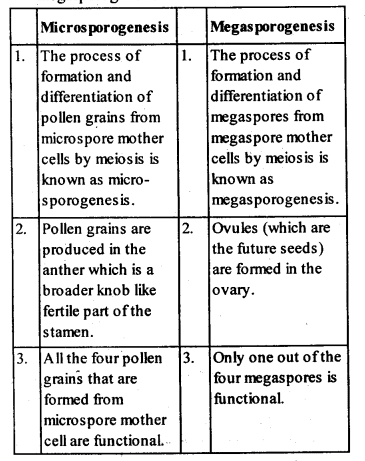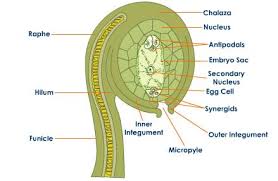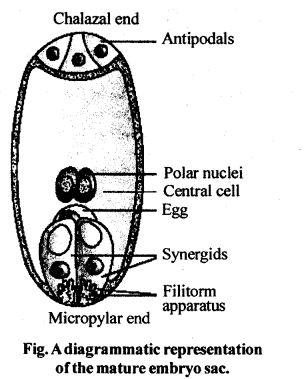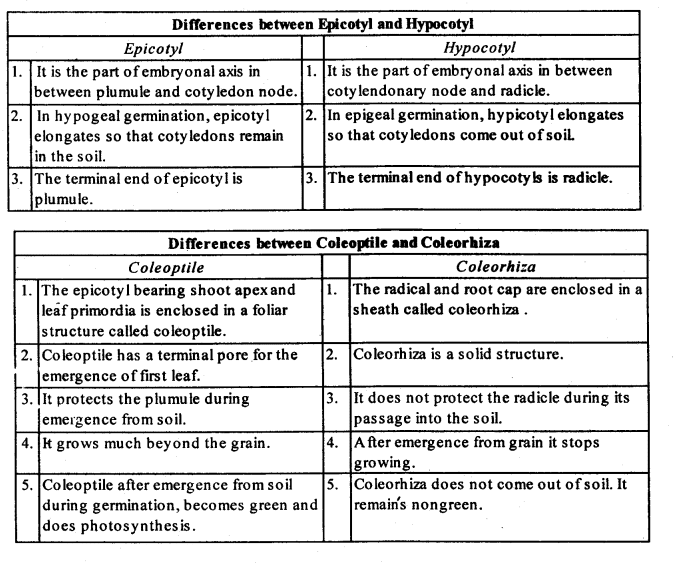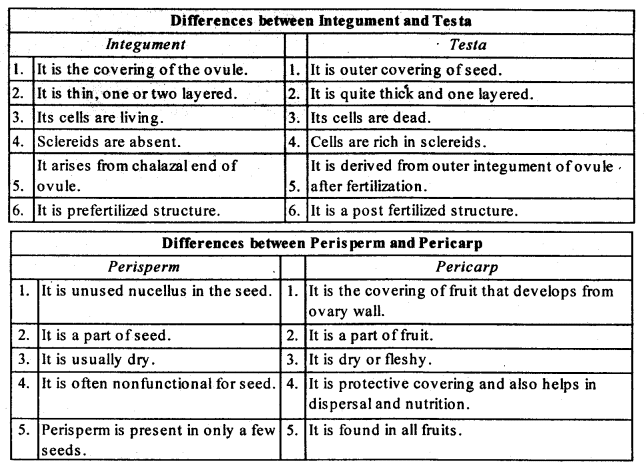Topics and Subtopics in NCERT Solutions for Class 12 Biology Chapter 2 Sexual Reproduction in Flowering Plants:
| Section Name | Topic Name |
| 2 | Sexual Reproduction in Flowering Plants |
| 2.1 | Flower – A Fascinating Organ of Angiosperms |
| 2.2 | Pre-fertilisation : Structures and Events |
| 2.3 | Double Fertilisation |
| 2.4 | Post-fertilisation: Structures and Events |
| 2.5 | Apomixis and Polyembryony |
| 2.6 | Summary |
QUESTIONS FROM TEXTBOOK SOLVED
1.Name the parts of anangiosperm flower in which development of male and female gametophytes take place.
Ans. Development of male gametophyte (micro- gametogenesis) occurs in pollen sac of anther up to 2 – celled stage. The female gametophyte develops (megagametogenesis) in the nucellus of ovule.
2.Differentiate between microsporogenesis and megasporogenesis. Which type of cell division occurs during these events? Name the structures formed at the end of these two events?
Ans.Differences between microsporogenesis and megasporogenesis are as follows –
Each microspore mother cell and megaspore mother cell contain two sets of chromosomes and are therefore diploid. The diploid megaspore mother cell and microspore mother cell enlarges and undergo meiosis to produce, four haploid cells called megaspores and microspores respectively.The chromosome number is reduced by half and therefore megaspores and microspores are haploid.
Microsporogenesis and megasporogenesis give rise to pollen grains and embryo sac respectively. Pollen grain is the male gametophyte and embryo sac represents the female gametophyte.
3.Arrange the following terms in- the correct developmental sequence : Pollen grain, sporogenous tissue, microspore tetrad, pollen mother cell, male gametes.
Ans. Sporogenous tissue – pollen mother cell – microspore tetrad – pollen grains – male gametes.
4.With a neat, labelled diagram, describe the parts of a typical angiosperm ovule.
Ans.
A typical angiospermic ovule is a small structure which is formed in the ovary. Ovule first develops as a projection on the placenta and composed of multilayered cellular tissue called the nucellus. The hypodermal cell of die nucellus enlarges and transformed into megaspore mother cell. This cell undergoes meiosis to produce four haploid cells only one of which develops & forms embryo sac (female gametophyte). An ovule may be surrounded by one or two protective layers called integuments, leaving a small opening at one end termed as micropyle which acts as passage for the entry of the pollen tube into the ovule. Thus, a typical ovule consists of a fully developed embryo sac with the nucellus and integuments.
5.What is meant by monosporic development of female gametophyte?
Ans. In many flowering plants, only one out of the four megaspores enlarges and develops into female gametophyte or embryo sac. The other three megaspores degenerate. This type of embryo sac formation is called as monosporic type of development.
6. With a neat diagram explain the 7-celled, 8- nucleate nature of the female gametophyte.
Ans.
Embryo sac (or female gametophyte) is formed by three successive mitotic divisions that take place in the nucleus of megaspore.
The nucleus of the functional megaspore divides meiotically to form two nuclei which move to the opposite poles, forming the 2-nucleate embryo sac. Two more sequential mitotic nuclear divisions result in the formation of the 4-nucleate and later the 8-nucleate stages of the embryo sac. After the 8-nucleate stage, cell walls are laid down leading to the organisation of the typical female gametophyte or embryo sac. Six of the eight nuclei are grouped together at micropylar and chalazal end and form the egg apparatus and antipodals respectively. The large central cell left over with two polar nuclei. Thus, a typical female gametophyte consists of 7 cells with 8 nucleus.
7. What are chasmogamous flowers? Can cross-pollination occur in cleistogamous flowers? Give reasons for your answer.
Ans. Chasmogamous flowers or open flowers in which anther and stigma are exposed for pollination. Cross-pollination cannot occur in cleistogamous flowers. These flowers remain closed thus causing only self-pollination. In cleistogamous flowers, anthers dehisce inside the closed flowers. So the pollen grains come in contact with stigma. Thus there is no chance of cross¬pollination, e.g., Oxalis, Viola.
8. Mention two strategies evolved to prevent self-pollination in flowers.
Ans. Continued self-pollination decreases the vigour and vitality of a particular race. Thus, flowering plants have developed many devices to discourage self-pollination and to encourage cross-pollination.
Dichogamy and self-sterility are.two most common devices that ensure cross-pollination. Dichogamy – Maturation of anther and stigma at different times in a bisexual flower prevent self-pollination.
Self-sterility (or self-incompatibility) – Due to the presence of self-sterile gene in some flowers, pollen grains do not germinate on the stigma of that flowers. e.g.,- tobacco, potato.
9. What is self-incompatibility? Why does self-pollination not lead to seed formation in self-incompatible species?
Ans. When the pollen grains of an anther do not germinate on the stigma of the same flower, then such a flower is called self-sterile or incompatible and such condition is known as self¬incompatibility or self-sterility.
The transference of pollen grains shed from the anther to the stigma of the pistil is called pollination. This transference initiate the process of seed formation. Self-pollination is the transfer of pollen grain shed from the anther to stigma of pistil in the same flower. But in some flower self¬pollination does not lead to the formation of seed formation because of the presence of same sterile gene on pistil and pollen grain.
10.What is bagging technique? How is it useful in a plant breeding programme?
Ans. It is the covering of emasculated flowers (removal of anthers in bud condition from a bisexual flower by a bag of butter paper or polythene in their bud condition i.e., before anthesis) to prevent contamination of its stigmas with unwanted pollens. When the stigmas of emasculated flowers mature the bags are removed, stigmas are dusted with pollen grains of desired male . plants by means of a presterilized brush and flowers are rebagged till fruit develop. This technique is mainly used in artificial hybridization. Plant breeders often use this technique to prevent the contamination of stigma of the flowers from unwanted pollen grains.
11.What b triple fusion? Where and how does it take place? Name the nuclei involved in triple fusion.
Ans. Fusion of second male gamete with die two polar nuclei located in the central cell to form the triploid primary endosperm nucleus (PEN) is called triple fusion or vegetative fertilization. This process takes place in the embryo sac. After reaching the ovary, pollen tube enters into the embryo sac from the micropylar end. After penetration, the tip of the pollen tube ruptures releasing the two male gametes. The one male gamete fuses with the egg to form the diploid zygote. This process is called syngamy and the other male gamete fuses with the two polar nuclei to form the triploid primary endosperm & this process is known as triple fusion. These two events of fertilization constitute the process of double fertilization.
12.Why do you think the zygote is dormant for sometime in a fertiUsed ovule?
Ans. The zygote after a period of rest develops into embryo. Most zygotes remain dormant till certain amount of endosperm forms. They do so, to provide assured nutrition to the developing embryo.
13. Differentiate between:
(a)hy pocotyl and epicotyl;
(b)coleoptile and coleorrhiza;
(c)integument and testa;
(d)perisperm and pericarp.
Ans:
14.Why is apple called a false fruit? Which Part(s) of the flower forms the fruit?
Ans. Botanically ripened ovary is called a true fruit. The fruits in which thalamus and other floral parts develop along with the ovary are called false fruits. For example – apple, strawberry, cashew etc. In apple the main edible portion of the fruit is the fleshy thalamus. Ovary forms the fruit after fertilization or without fertilization in parthenocarpic fruits.
15.What is meant by emasculation? When and why does a plant breeder employ this technique?
Ans. Emasculation is the removal of stamens mainly the anthers from the flower buds before their dehiscence. This is mainly done to avoid self-pollination. Emasculation is one of the measures in the artificial hybridization. Plant breeders employed this technique to prevent the pollination within same flower or to pollinate stigmas with pollens of desired variety.
16.If one can induce parthenocarpy through the application of growth substances, which fruits would you select to induce parthenocarpy and why?
Ans. Parthenocarpic fruits are seedless. They develop from ovary without fertilization. Banana, grapes, oranges, Pineapple, Guava, Watermelon, lemon are selected because these seedless of units are of high economic importance. The fruits in which seeds or seed part form edible portion (e.g.,Pomegranate) are not selected to induce parthenocarpy.
17.Explain the role of tapetum in the formation of pollen-grain wall.
Ans. Tapetum is the innermost layer of the microsporangium. The tapetal cells are multinucleated and polyploid. They nourish the developing pollen grains. These cells contain ubisch bodies that help in the ornamentation of the microspores or pollen grains walls. The outer layer of the pollen grain is called exine and is made up of the sporopollenin secreted by the ubisch bodies of the tapetal cells. This compound provides spiny appearance to the exine of the pollen grains.
18.What is apomixis and what is its importance?
Ans. Apomixis is a mode of asexual reproduction that produces seeds without fertilization, e.g.- some species of Asteraceae and Grasses. This method is important in hybrid seed industry. Hybrids are extensively cultivated for increasing productivity. But the main drawback is that the hybrid seeds are to be produce every year because the seeds of the hybrid plants da not maintain hybrid characters for longer period due to segregation of characters. This can be avoided if apomixis can be introduced in hybrid seeds. For this reason scientists are trying hard to identify genes for apomixis.
